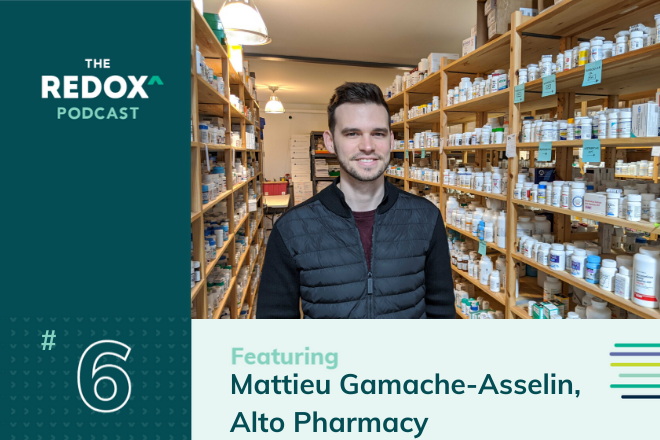The Redox Podcast 6: Pharmacy of the future with Alto’s Mattieu Gamache-Asselin
Jan 29, 2020

Key Moments
2:00 - From an engineer at Parse, to being acquired by Facebook, then founding Alto 6:20 - Matt buys a small retail pharmacy 10:30 - From a mom and pop shop to the pharmacy of the future 13:00 - The complex workflow involved in getting meds to patients 15:30 - Pharmacy Benefits Managers (PBMs) - what are they and what’s their part in drug pricing
“Find ways to apply technology – not to create something cool and slick, but to make things better for patients. Just a little bit better – incrementally better – and keep doing that. If more people took that approach, I think we’d be in a different position in terms of health tech.”
Mattieu Gamache-Asselin, CEO, Alto
My Lyft pulled up to Alto just as one of their first employees was rolling up the metal gates covering the front windows to a tiny retail enclave with minimally stocked wooden shelves: one or two over-the-counter basics, sunscreen, ointments—some of the things you’d find in a retail pharmacy, only 95% less of them. It’d be about an hour until the doors would open to customers stopping in to pick up their specialty meds and speak to their pharmacists.
On the counter was an iPad check-in kiosk and a modern point-of-sale system, at the edge a couch created the neat waiting area where I sat for a moment before my host arrived.

Carrying a cup of Philz coffee, Matt wore jeans and a light jacket over a tee like any San Francisco-based tech CEO. In stark contrast, I wore a sports coat and dress shoes, allowing me to seamlessly fit in with the army of suits that march upon SF each January for JPM.
Matt walked me through their pharmacy operations where technicians pull pill bottles and work an array of fancy bottling, counting, and packaging machines. Over the shoulder of one of the technicians, I glimpsed Alto’s software, designed to coordinate what I christened the five Ps of pharmacy—the patient, provider, pharmacy, PBM, and payer. The PBM or pharmacy benefits manager may be the most complicated part of the mix, negotiating rebates, discounts, and formularies among manufacturers and insurers.

We set up a makeshift podcast studio in the corner conference room. I dove in with Matt about where exactly we were, his roots, how Alto became the company it is today and where it plans to go in the years to come. Extremely insightful and genuine, he is relentless in his quest to simplify the tangled mess of how patients get the meds they need.
As patients we often find ourselves waiting in astonishment, wondering why it takes so long to put a few pills in a bottle and ring them up. But behind the scenes is a morass of information exchange, insurance contracts, middlemen, brands versus generics, phone calls, faxes, cross-subsidies, and misaligned incentives. In the interview, I discovered just how complicated this world has become. Embedded as the status quo is a convoluted system that has evolved to optimize benefits for a generation of entrenched players.
In the markets Alto serves, patients can find a bright spot. Couriers deliver meds to their door and pharmacists are available via a good old landline. And there’s an app to streamline the whole process.
On the national scale, Alto remains relatively unknown to consumers. Rather than rapid expansion, they’ve chosen a disciplined route of nailing the few markets they’re in, ensuring great customer experience, operations, and the economics of their new model. I have a feeling we’ll be seeing them a lot more in the years to come.
We were both headed up to SoMa so Matt offered to share a ride. He popped out at Alto’s new business offices and I rejoined the bustle of JPM, just in time to start a day of back-to-back introductions and endless receptions in awkward meeting spaces.

***
On January 30, 2020, news broke that Alto closed a funding round of $250 from SoftBank’s Vision Fund 2.
